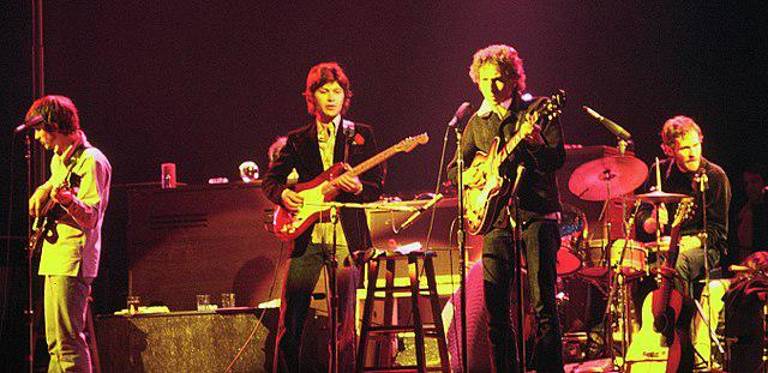The Band’s Robbie Robertson Lived in a Magical New York
The one time resident of the fabled Chelsea Hotel, was Canadian born but was a true New Yorker. He was also part of the transformation when Bob Dylan dropped his acoustic folk bard style and stunned his early fans when he “went electric.” Robbie Robertson and the Band were with him in the transition and a big reason why it succeeded. But he also played with a who’s who of rock legends over the years.

Robbie Robertson, the leader of The Band who died on Aug. 9, was a true New Yorker.
Back in 1965 and 1966, he called Manhattan home, living in the fabled Chelsea Hotel, the Gramercy Park area and the West Village. Robertson and his band hunkered down here in between concerts with Bob Dylan, whom they were backing in the tumultuous days when Dylan left folk music behind and famously “went electric.”
Robertson happily took advantage of the cultural gifts that the city could offer an intensely curious and adventurous 22-year-old man. You’d need a scorecard to keep track of the diverse group of creative forces that he met or hung out with or made music with.
Naturally, rock fans think immediately of Robertson and The Band as creatures of Woodstock, flashing back to an ugly but iconic house/headquarters known as Big Pink. They collaborated with Bob Dylan on The Basement Tapes, their informal recording sessions, in 1967 and made upstate New York their base until they relocated to Malibu in 1973.
New York in 1966
Robertson, a native of Toronto, wrote vividly and lovingly in his riveting 2016 memoir, Testimony. New York was a magical and inspiring place for him. The city exposed him to musicians, artists and others who fired up the imagination of the creative force who would go on to write such classic songs as “The Weight,” “King Harvest,” “Up on Cripple Creek,” “Daniel and the Sacred Harp,” and “Stage Fright.”
With 20/20 hindsight, of course, Robertson fit in well in a city as bustling as New York. He was, after all, a one-man melting pot. His mother was born on the Six Nations Indian Reserve in southwestern Ontario and his birth father, a card shark who died before Robertson’s first birthday, was Jewish.
He met a dizzying cast of characters in the city’s exploding musical scene, ranging from a then-unknown Jimi Hendrix (still calling himself “Jimmy James”) and members of the Lovin’ Spoonful to Lou Reed, then of the burgeoning Velvet Underground (a band which left Robertson largely unimpressed). Robertson talked about art and culture with Salvador Dali, pined for the mysterious and lovely singer Nico and was pals with Andy Warhol’s muse, Edie Sedgwick. He played guitar for Carly Simon, well before she became a famous singer, and even backed Tiny Tim in the music studio.
He and The Hawks, the group that later became known as The Band, backed Dylan at Carnegie Hall on Oct. 1, 1965, and toured the world. Robertson played lead guitar on “One of Us Must Know,” one of Dylan’s greatest songs, in New York in January 1966 and went on to and support Dylan when the recording process moved to Nashville for Dylan’s remarkable, ground-breaking 1966 album, Blonde on Blonde.
Robertson’s New York
Robertson fondly writes in his memoir, Testimony, and remembered in the movie The Last Waltz his earliest excursions to Manhattan as a teenager.
He accompanied rockabilly singer Ronnie Hawkins to the Brill Building to meet rock and roll songwriters and find songs that Hawkins could record. Robertson crashed in Times Square, where there were movie theaters forever and all those “friendly women” walking along the streets.
The Manhattan that Robertson called home in 1966 truly sounds like a place from a long time ago. He and his girlfriend, and later his wife, Dominique, (with their two kittens in tow) and bandmate Richard Manuel lived in an $89-a-month, two-bedroom apartment on the corner of Bedford and Seventh Avenue South. Imagine trying to find a deal like that today!
Robertson has great affection for the times he had when he accompanied Dylan around town in the mid-1960s. Robertson noted in Testimony: “His world revolved around art, poetry and music, and the scene swirled with an almost atomic energy. Whether uptown or downtown, the streets were alive with music. I felt like I had a front-row seat for the cultural explosion that was changing the world.”
Robbie Robertson was a lucky young man in those high-spirited days. He got to experience Manhattan just as the city was changing and making room for the youth revolution that Dylan and The Beatles had stirred.
Our New York
Many of us arrived in Manhattan in our early twenties, eager to experience everything that the city could offer. We hoped to find special hangouts, meet dynamic doers and change the way we viewed ourselves and the world.
Robbie Robertson was in the right place at the right time. He took it all in, learned a lot about city life and loved his time here. He will be missed as a brilliant songwriter and guitarist, who left his mark on rock and roll. And we all miss the city he called home nearly 60 years ago.
And I will immortalize Robbie’s Manhattan until somebody rents me a two-bedroom apartment at Bedford and Seventh Avenue South for 89 bucks a month.
I felt like I had a front-row seat for the cultural explosion that was changing the world.” Robbie Robertson